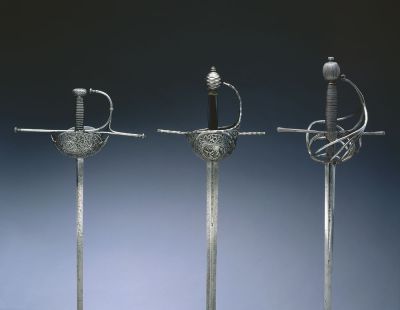The word “rapier” refers to a sword with a long, narrow blade intended primarily for thrusting maneuvers and generally with some degree of hand protection formed by an elaborate hilt. Such swords were popular civilian weapons in the 16th and 17th centuries. The blade of the rapier, over time, became longer based on a belief that a longer blade made it possible to hit one’s adversary more easily and, at the same time, to stay beyond the reach of his weapon. The rapier was worn with a gentleman’s civilian dress and used for dueling or self-protection. These long thrusting weapons were illustrated in Italian fencing treatises such as Salvator Fabris’s “Scienza d’Arme” and Francesco Alfieri’s “L’Arte di Ben Manegiarre La Spada.” Though the rapier, as a specialized form of the sword, was in use all over Europe as a weapon for settling duels, it appears to have originated in Italy. During the late Renaissance and early Baroque eras, Italian swordsmen were probably the most famous for their skill with this weapon and Milan was a leading center for their production.
For male civilians, the wearing of rapiers suspended on their garments was far more than self-defense. They were worn in accordance with contemporary taste and fashion. Rapiers were important accessories for a gentleman’s civilian costume and became a form of male jewelry that indicated status, wealth and refined taste. The term “rapier,” though of uncertain origin, may derive from the Spanish espada ropera, meaning “robe sword” or dress sword. The Englishman Sir John Smythe complained in his “Certain Discourses Militarie” (1590) that the slender blade of the rapier was easily broken and that its great length made it difficult to draw. Nevertheless, the new technique of swordplay, with its emphasis on the point of the blade, made necessary a complicated structure for the sword’s guard to protect the duelist’s hand.
During the 1500s, fencing academies emerged in cities like Milan, Venice and Verona and elaborate rules of fencing were developed. Two schools of fencing were prevalent in the 16th century, the Spanish and the Italian, both of which called for the use of a “parrying dagger” to be held in the hand opposite the sword hand. The dagger was intended to block or entrap the opponent’s rapier thrusts, a technique known as parrying. Parrying daggers were often made together with rapiers as a matched set, or garniture, during the 17th century. Italian and Spanish schools of fencing with two armed hands dominated Europe from about 1500 to 1650 when the French style of fencing with a small sword alone eventually gained prominence.
The rapier evolved a bewildering array of hilt forms, ranging from the simple cup hilts to complex swept hilts with various knuckle guards often impeccably decorated. The Italian aristocracy’s taste for rich and intricate styles of decoration led to extravagant gilding, chiseling, piercing, enameling, and silvering and sword hilts became deeply personalized. The more costly or unusual these weapons appeared, the more they were desired by the elite clientele who commissioned them, not only for dueling but also as the ultimate accessory. In the Armor Court of the Cleveland Museum of Art may be seen notable examples including a Milanese “Cup-Hilted Rapier” dating to about 1610-1630. The hilt, beautifully pierced and chiseled, would no doubt have made its original owner proud. Nearby in the Armor Court will also be seen a “Portrait of a Man” by Antonio Tanzio da Varallo of 1620. The sitter’s identity is not known. He wears fine clothes including a lace collar and a handsome red sash. He holds his hat, finely decorated with a feather and hat jewel, in his left hand. Just below is the lavishly decorated hilt of his rapier prominently displayed in the portrait. In fact, the sitter conspicuously assumes a three-quarter pose in order to place his rapier, of which he was no doubt proud, in prominent line of sight for the viewer.
Gradually, with the development of the rapier and its later descendants, the sword was no longer the prerogative of the aristocrat alone, but of anyone who could afford to have one made. Specialized shops of swordsmiths would have been found in major Italian cities where custom-made rapiers may have been ordered to match one’s costume and display one’s individual taste. Indeed, such was the demand for personalized side arms that some of the foremost artists of the day provided fashionable designs to the swordmakers, goldsmiths and jewelers who collaborated on these extravagant weapons. During the 16th century, for example, artists like Benvenuto Cellini are known to have produced such designs. The hilts of rapiers, particularly those produced in the Milanese workshops, became consummate decorative art objects that superseded their original function as weapons.
The rapier gradually fell from favor among northern and central Europeans during the final decades of the 17th century and was replaced by the smallsword, a much lighter and more slender relative with a simple hilt and a fairly short, stiff blade that offered greater control. However, we can admire rapiers today in museum collections as expressions of masculine taste in an era when swords were worn more for their decorative interest than their function as weapons. Italy then, as it is now, was the fashion trendsetter.
https://www.lagazzettaitaliana.com/history-culture/8517-elegance-achieved-the-italian-rapier#sigProId716ceb0b3e




